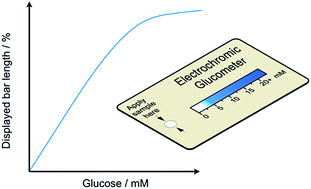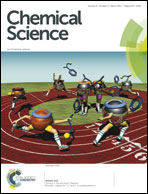Quantitative self-powered electrochromic biosensors†
Abstract
Self-powered sensors are analytical devices able to generate their own energy, either from the sample itself or from their surroundings. The conventional approaches rely heavily on silicon-based electronics, which results in increased complexity and cost, and prevents the broader use of these smart systems. Here we show that electrochromic materials can overcome the existing limitations by simplifying device construction and avoiding the need for silicon-based electronics entirely. Electrochromic displays can be built into compact self-powered electrochemical sensors that give quantitative information readable by the naked eye, simply controlling the current path inside them through a combination of specially arranged materials. The concept is validated by a glucose biosensor coupled horizontally to a Prussian blue display designed as a distance-meter proportional to (glucose) concentration. This approach represents a breakthrough for self-powered sensors, and extends the application of electrochromic materials beyond smart windows and displays, into sensing and quantification.



 Please wait while we load your content...
Please wait while we load your content...